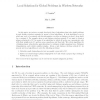641 search results - page 111 / 129 » On Planar Quasi-Parity Graphs |
JGAA
2008
13 years 7 months ago
2008
Let G be a bipartite graph, and let e, i be two parallel convex curves; we study the question about whether G admits a planar straight-line drawing such that the vertices of one p...
JGT
2008
13 years 7 months ago
2008
: This article proves the following result: Let G and G be graphs of orders n and n , respectively. Let G be obtained from G by adding to each vertex a set of n degree 1 neighbors....
DM
2010
13 years 8 months ago
2010
Let Mad(G) denote the maximum average degree (over all subgraphs) of G and let i(G) denote the injective chromatic number of G. We prove that if Mad(G) 5 2 , then i(G) + 1; sim...
GD
2007
Springer
13 years 11 months ago
2007
Springer
Abstract. A graph is planar if and only if it does not contain a Kuratowski subdivision. Hence such a subdivision can be used as a witness for non-planarity. Modern planarity testi...
JDA
2007
13 years 7 months ago
2007
In this paper, we review a recently developed class of algorithms that solve global problems in unit distance wireless networks by means of local algorithms. A local algorithm is ...

